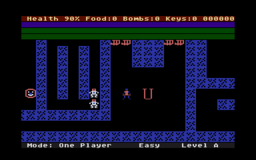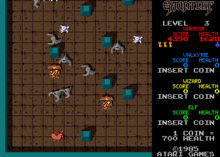Dandy (video game)
| Dandy | |
|---|---|
 | |
| Developer(s) | John Palevich |
| Publisher(s) | Atari Program Exchange |
| Designer(s) | John Palevich |
| Engine | custom, 6502 assembler |
| Platform(s) | Atari 8-bit |
| Release date(s) | 1983 |
| Genre(s) | dungeon crawl, action-adventure game |
| Mode(s) | single to four player |
| Distribution | floppy disk, cassette |
Dandy (later Dandy Dungeon) is a dungeon crawl computer game for the Atari 8-bit computers. Dandy was one of the first games to offer simultaneous, four-player, cooperative play and a built-in editor. It served as the inspiration for the popular Atari Gauntlet series.
Gameplay
Dandy took place in a dungeon consisting of a series of 2D mazes drawn in a top-down fashion. The dungeon as a whole had multiple maze levels, connected together using stairwells. Portions of the mazes were also blocked off by locked doors, which could be opened by finding the keys scattered through the maze. The basic goal of the game was to fight through the maze to the next stairwell, from there to the next level, and proceed through the dungeon's levels to the end.
The players were armed with a sort of bow and arrow, which could be shot in any of the eight cardinal directions. Monsters came in several varieties, although the difference was strictly graphical. When hit, the monsters would "devolve" to the next less-powerful state, before eventually being killed and disappearing. Some monsters were placed in the maze during its pre-game creation and appeared as soon as that level was entered, while others were produced in "monster generators", skull-shaped objects placed in various locations.
Monsters touching the player would reduce the player's health, which could be improved by eating food. Food was scattered around the dungeon and was picked up on the way. Potions were also available, which would destroy every monster on the screen when activated. Potions could be either shot with the arrow, or picked up and carried for later use. A special "heart of gold" could also be collected, and used to revive dead party members.
The players interacted with the game primarily through the joystick, although there were a limited number of keys for eating food or using the potions. When two or more players played at once, the screen scrolled according to the average location of the group. This encouraged players to cooperate to explore the dungeon.
The game map was created using a custom character set drawn in the Atari's five-color text mode, moving about as the characters reached the edges of the visible portion of the map. Each dungeon level was three screens wide and high. The Atari's special smooth scrolling hardware was used to pan around the level, while the player/missile graphics capabilities were not used.
The game included a level editor that enabled ambitious players to design new dungeons and exchange them with other players.
History
Thesis of Terror
What became Dandy was originally written in the fall of 1982 as Thesis of Terror, Jack Palevich's MIT bachelor's thesis.[1] The original concept was for a five-person game, four players on Atari computers acting as graphical terminals, and a fifth machine acting as dungeon master controlling the action from a separate computer. The two machines would communicate over their serial ports. However, time constraints meant that the interactive dungeon master role was never implemented. The separate machine, a Hewlett-Packard Pascal Workstation (a member of the HP 9000 family), was used solely as a file server, sending new maps to the Atari on demand.
The game engine was inspired by John Conway's Game of Life. Life is cellular automata; at each "turn" the game examines the squares on the grid that makes up the playfield, and uses a basic calculation to determine whether or not that square should hold a cell. In Dandy this same basic mechanism is used, but the decision was essentially "if the player is on that side of the cell, and there is a monster on the other side, then I will hold a monster on the next turn." This gave the illusion of the monsters chasing the player, when in fact they did not move at all. Like a marquee, the motion was an illusion as they simply turned on or off. This algorithm was easy to implement using the limited resources of the Atari 800; it took the same time to run no matter how many monsters were currently in the map. It also had the property that any dungeon that could be drawn in the editor would run correctly and efficiently, the designer did not have to worry about "correct" placement of the monsters or generators to ensure the map would.
The gameplay design of Thesis of Terror was heavily influenced by Dungeons and Dragons; Palevich had never actually played D&D, but he had read through the manuals and watched some of his dorm-mates play campaigns in the lounge of MIT's New House II dormitory. The new name Dandy is a play on the phonetic pronunciation of D and D, which at the time was a generic term for dungeon adventure role-playing games. Dandy was also influenced by the Defender arcade game, which contributed the idea of the smart bomb (potions), and by several maze-exploration arcade games that contributed the idea of using keys to unlock doors. Dandy was not influenced by any of the roguelike games, as Palevich was unaware of Rogue at the time Dandy was designed.[2]
Thesis of Terror's gameplay was designed with help from Joel Gluck, who was a freshman at MIT at the time. Gluck designed several of the levels in the game, and invented some of the common idioms of Dandy-style games. For example, he designed the "funnel trap", where treasure was placed in such a way that the players would run to the treasure, causing a wall of monsters placed just off screen to activate and charge on the party.
Several changes were made to the gameplay as a result of playtesting. Early versions of the game allowed players to shoot each other, but this was removed after testing showed that when the players discovered that they could hurt each other, the game quickly degenerated into a chaotic free-for-all. Another change was that dead players originally had to sit out the rest of the game. Testing revealed that parties would start the game over when one member died, so that the whole party could continue to play together. To keep the game going, the revival heart was added.
Creation of Dandy
After graduating from MIT, Palevich went to work for Atari in the Atari Research division, where he worked on VLSI graphics and sound chips, and also helped design the custom operating system for the unreleased Atari Rainbow personal computer. Of all these projects only the Atari AMY sound chip ended up making it to market.[3]
While working at Atari, Palevich continued developing the game. During the period from February to May 1983 the original was cleaned up for release, and it was during this period that the name became Dandy. The workstation was removed, and the dungeon master's role was reduced to laying out the maps and saving them to floppy disk. Another change was to remove the ability to return to higher levels of the dungeon. This change was made after play-testing revealed that nobody ever went up to previous levels, except by mistake. Removing this feature sped up level changes, because the maze state no longer had to be written out to disk before the next level was loaded. It also enabled the game to work on cassette tape as well as on disk; on the tape version the cassette tape was stopped between levels, and then started up again to load the next level.
Atari Program Exchange advertised Dandy as "the great new team game ... Bring up to three friends! Work as a team to battle monsters!", with a cartoon of four children exploring a dungeon.[4]
Dandy and Gauntlet

Two years after Dandy 's release, Atari arcade division programmer Ed Logg and his team wrote Gauntlet. During a speech given at the 2012 Game Developers Conference, Ed Logg said that Dandy served as direct inspiration for Gauntlet.[5]
Palevich later sold the rights to Dandy to a British game developer, Electric Dreams Software, who released versions for the ZX Spectrum, Commodore 64 and Amstrad CPC in 1986. They chose to make a Gauntlet clone, rather than a Dandy clone, and as a result, the British developer was later sued by Atari.[6]
Post-Gauntlet
When Atari decided to re-enter the game console business in the late 1980s, they made a new Dandy-like game known as Dark Chambers. The manual states "Copyright 1983 John Howard Palevich. All rights reserved."[7] Dark Chambers was released for the Atari 2600, Atari 7800 and Atari XE computers in 1988. This version supported only two players as the additional joystick ports had been removed from the 8-bit machines some time earlier.
Palevich has experimented with rewriting the core Dandy engine in a variety of programming languages. The original version is around 4,000 lines of 6502 assembly language, that took about 100 hours to write. Cloning the game on a modern computer using C++ took about 1200 lines of code and 12 hours. John has released a source-code version of the game for both Microsoft Windows and the Xbox 360.[8]
References
- ↑ "Dandy". atariarchives.org. Retrieved 2010-08-25.
- ↑ "A History of Dandy Dungeon". Retrieved 2013-11-02.
- ↑ "Atari 65XEM", see "One of the original programmers of the AMY chips software was John Palevich..."
- ↑ "It's Dandy!". Softline (advertisement). Nov–Dec 1983. p. 56. Retrieved 29 July 2014.
- ↑ "GDC 2012 - Gauntlet Post Mortem with Ed Logg". Retrieved 7 March 2012.
- ↑ "Before Gauntlet, There Was…Dandy Dungeon". Vintagecomputing.com. 2006-01-04. Retrieved 2010-08-25.
- ↑ "Atari 7800 Manuals (HTML) - Dark Chambers (Atari)". AtariAge. Retrieved 2010-08-25.
- ↑ "Dandy - A 2D game written in F#". Cs.hubfs.net. Archived from the original on September 24, 2008. Retrieved 2010-08-25.